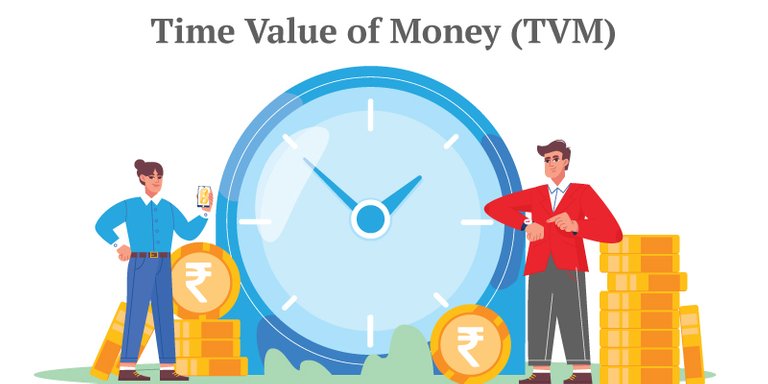What is Time Value of Money?
Time value of money (TVM) is the concept that the value of money today is worth more than the same amount of money in the future. In other words, a dollar received today is worth more than a dollar received one year from now. The reason for this is because money has the potential to earn interest or grow over time. Therefore, the longer you hold onto your money, the more it can grow, making it more valuable in the future.

image source
How Does Time Value of Money Work?
The time value of money refers to the principle that a dollar today is worth more than a dollar in the future because of its earning potential over time. To illustrate this concept, let's consider the following example:
Suppose you have $1,000 and you can either invest it in a savings account that pays 2% interest per year or spend it now. If you decide to invest the $1,000 in the savings account, you will have:
$1,020 after one year (original $1,000 + 2% interest)
$1,040.40 after two years (original $1,000 + 2% interest in year one + 2% interest in year two)
$1,061.21 after three years (original $1,000 + 2% interest in year one + 2% interest in year two + 2% interest in year three)
and so on...
This means that if you decide to spend the $1,000 now, you are giving up the potential to earn interest and accumulate wealth over time. Therefore, the time value of money implies that a dollar received today is worth more than the same dollar received in the future.
Discounting a cash flow a year from today:
Suppose you are expecting to receive $1,000 one year from today as payment for a job you will complete. However, you want to know what that $1,000 is worth today, taking into account the time value of money.
To do this, you need to discount the future cash flow back to its present value. Assuming a discount rate of 5%, the present value of the $1,000 payment one year from now would be:
PV = FV / (1 + r)^n
PV = $1,000 / (1 + 0.05)^1
PV = $952.38
This means that the present value of the $1,000 payment one year from now, discounted at a rate of 5%, is $952.38. In other words, if you were to receive $952.38 today and invested it at a rate of 5%, it would grow to $1,000 in one year.
Discounting future cash flows is important in financial decision making because it allows you to compare the value of cash flows that occur at different points in time. By discounting future cash flows to their present value, you can evaluate the feasibility of investments, calculate the value of assets, and determine the appropriate price to pay for an investment or a company.
The concept of TVM is based on the idea of compounding, which means that interest earned on an initial investment is added to the principal amount, and the new total becomes the basis for calculating interest in the future. The longer the investment period, the more significant the impact of compounding, resulting in higher returns.
Why is Time Value of Money Important?
Understanding TVM is crucial in making financial decisions that involve time and money. It helps individuals and businesses determine the true cost or value of an investment, loan, or other financial transaction. For instance, if you are considering taking out a loan, you can use TVM to calculate the total cost of the loan, including interest payments. This will help you make an informed decision on whether the loan is worth taking or not.
Moreover, TVM helps individuals and businesses plan for their future financial needs. By understanding how money grows over time, you can make better decisions about saving, investing, and retirement planning. TVM can also help you evaluate different investment options and choose the one that offers the highest return.
Time value of money is a critical concept in finance that everyone should understand. It helps us make better financial decisions, plan for our future, and achieve our financial goals. By recognizing the power of time in finance, we can take control of our money and make it work for us, rather than against us.
Time value of money was an important aspect of my job when I worked in the Cost Benefit Analysis (CBA) Team for the Queensland Government. We typically used discount rates of 4% and 7%. It made quite a difference as project had evaluation periods as long as 30 years. These rates were determined on a national level so we had no say in determining them. I think it makes sense to have more than one discount rate for the purpose of sensitive testing results.
Yes, Time value of money is really important. Particularly when initiated new project. But we use discount rate more than 7% in calculation. Thanks for your comments.